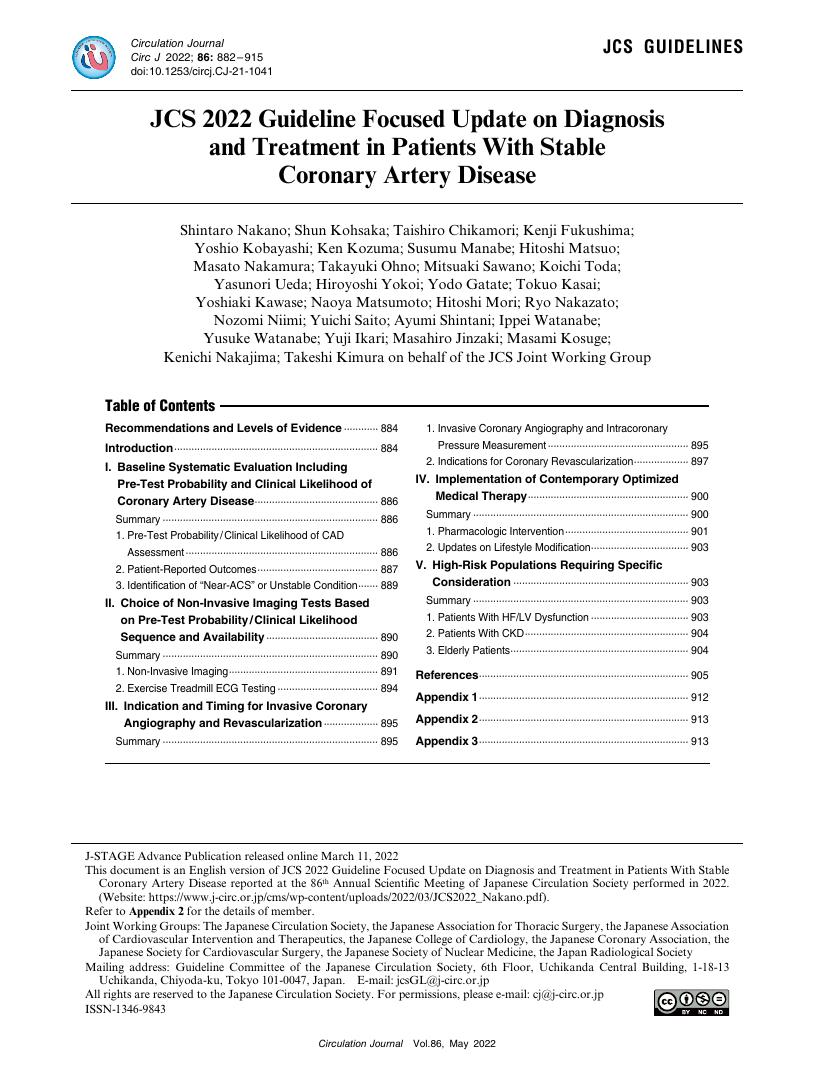17 0 0 0 OA Contemporary Management of Stable Coronary Artery Disease ― Implications of the ISCHEMIA Trial ―
- 著者
- Shun Kohsaka Kenji Fukushima Ippei Watanabe Susumu Manabe Nozomi Niimi Yodo Gatate Mitsuaki Sawano Shintaro Nakano
- 出版者
- The Japanese Circulation Society
- 雑誌
- Circulation Journal (ISSN:13469843)
- 巻号頁・発行日
- pp.CJ-21-0345, (Released:2021-06-18)
- 参考文献数
- 68
- 被引用文献数
- 3
Coronary artery disease (CAD) remains a leading cause of mortality and morbidity in developed countries. Although urgent revascularization is the cornerstone of management of acute coronary syndrome (ACS), for patients with stable CAD recent large-scale clinical trials indicate that a mechanical ‘fix’ of a narrowed artery is not obviously beneficial; ACS and stable CAD are increasingly recognized as different clinical entities. We review the perspectives on (1) modifying the diagnostic pathway of stable CAD with the incorporation of modern estimates of pretest probability, (2) non-imaging evaluations based on their availability, (3) the optimal timing of invasive coronary angiography and revascularization, and (4) the implementation of medical therapy during the work-up.
11 0 0 0 OA JCS 2022 Guideline Focused Update on Diagnosis and Treatment in Patients With Stable Coronary Artery Disease
- 著者
- Shintaro Nakano Shun Kohsaka Taishiro Chikamori Kenji Fukushima Yoshio Kobayashi Ken Kozuma Susumu Manabe Hitoshi Matsuo Masato Nakamura Takayuki Ohno Mitsuaki Sawano Koichi Toda Yasunori Ueda Hiroyoshi Yokoi Yodo Gatate Tokuo Kasai Yoshiaki Kawase Naoya Matsumoto Hitoshi Mori Ryo Nakazato Nozomi Niimi Yuichi Saito Ayumi Shintani Ippei Watanabe Yusuke Watanabe Yuji Ikari Masahiro Jinzaki Masami Kosuge Kenichi Nakajima Takeshi Kimura on behalf of the JCS Joint Working Group
- 出版者
- The Japanese Circulation Society
- 雑誌
- Circulation Journal (ISSN:13469843)
- 巻号頁・発行日
- pp.CJ-21-1041, (Released:2022-03-11)
- 参考文献数
- 245
- 被引用文献数
- 40
- 著者
- Risako Nakao Michinobu Nagao Kenji Fukushima Akiko Sakai Eri Watanabe Masateru Kawakubo Shuji Sakai Nobuhisa Hagiwara
- 出版者
- The Japanese Circulation Society
- 雑誌
- Circulation Reports (ISSN:24340790)
- 巻号頁・発行日
- pp.CR-18-0024, (Released:2019-07-26)
- 参考文献数
- 33
- 被引用文献数
- 4
Background:We investigated the association between left ventricle ejection fraction (LVEF) and vortex flow (VF), and whether cardiac resynchronization therapy (CRT) response can be predicted using VF mapping (VFM) in patients with dilated cardiomyopathy (DCM).Methods and Results:Cardiac magnetic resonance imaging data for 20 patients with heart failure (HF) with LVEF ≥40% and 25 patients with DCM with LVEF <40%, scheduled for CRT, were retrospectively analyzed. The maximum VF (MVF) on short-axis, long-axis and 4-chamber LV cine imaging were calculated using VFM. Summed MVF was used as a representative value for each case and was significantly greater for patients with DCM than for patients with HF with LVEF ≥40% (25.2±19.2% vs. 12.1±15.4%, P<0.005). Summed MVF was significantly greater for CRT responders (n=12, 35.8±22.7%) than for non-responders (n=13, 15.8±8.7%, P=0.04) during the mean follow-up period of 38.4 months after CRT. Patients with summed MVF ≥31.3% had a significantly higher major adverse cardiac event-free rate than those with MVF <31.3% (log-rank=4.51, P<0.05).Conclusions:On VFM analysis, LV VF interrupted efficient ejection in HF. Summed MVF can predict CRT response in DCM.
- 著者
- Shintaro Nakano Shun Kohsaka Taishiro Chikamori Kenji Fukushima Yoshio Kobayashi Ken Kozuma Susumu Manabe Hitoshi Matsuo Masato Nakamura Takayuki Ohno Mitsuaki Sawano Koichi Toda Yasunori Ueda Hiroyoshi Yokoi Yodo Gatate Tokuo Kasai Yoshiaki Kawase Naoya Matsumoto Hitoshi Mori Ryo Nakazato Nozomi Niimi Yuichi Saito Ayumi Shintani Ippei Watanabe Yusuke Watanabe Yuji Ikari Masahiro Jinzaki Masami Kosuge Kenichi Nakajima Takeshi Kimura on behalf of the JCS Joint Working Group
- 出版者
- The Japanese Circulation Society
- 雑誌
- Circulation Journal (ISSN:13469843)
- 巻号頁・発行日
- vol.86, no.5, pp.882-915, 2022-04-25 (Released:2022-04-25)
- 参考文献数
- 245
- 被引用文献数
- 40
